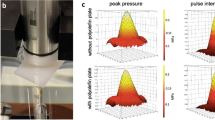Abstract
Purpose. Drug delivery to the central nervous system (CNS) is limited by the blood-brain barrier (BBB). Thus, a noninvasive and reversible method to enhance BBB permeation of drugs is highly desirable. In the present work, we studied if ultrasound-induced mild hyperthermia (USHT, 0.4 watts (W)/cm2 at 41°C) can enhance drug absorption in BBB endothelial cells, and we elucidated the mechanism of USHT on cellular accumulation.
Methods. To accomplish these aims, we studied the effects of hyperthermia (41°C), USHT, P-glycoprotein (P-gp) modulator (PSC 833), and combination of USHT and PSC 833 on accumulation of P-gp substrate (R123) and non-P-gp substrates (sucrose, 2-deoxyglucose, and antipyrine) in monolayers of primary bovine brain microvessel endothelial cells (BBMEC).
Results. USHT, through its thermal effect, produces a significant (relative to controls; no USHT) and comparable increase in R123 accumulation with PSC 833. We also demonstrate that USHT increases permeability of hydrophobic (R123 and [14C]-antipyrine) and not hydrophilic molecules ([14C]-sucrose and 2-[3H]-deoxy-d-glucose). The enhanced permeability is reversible and size dependent, as USHT produces a much larger effect on cellular accumulation of [14C]-antitpyrine (molecular weight of 188 D) than that of R123 (molecular weight of 380.8 D). Although USHT increases membrane permeability, it did not affect P-gp activity or the activity of glucose transporters.
Conclusions. Our results point to the potential use of USHT as a reversible and noninvasive approach to increase BBB permeation of hydrophobic drugs, including P-gp-recognized substrates.
Similar content being viewed by others
REFERENCES
S. I. Rapoport, K. Ohno, and K. D. Pettigrew. Drug entry into the brain. Brain Res. 172:354–359 (1979).
C. Cordon-Cardo, J. P. O'Brien, D. Casals, L. Rittman-Grauer, J. L. Biedler, M. R. Melamed, and J. R. Bertino. Multidrugresistance gene (P-glycoprotein) is expressed by endothelial cells at blood-brain barrier sites. Proc. Natl. Acad. Sci. USA 86:695–698 (1989).
S. Seetharaman, L. Maskell, R. J. Scheper, and M. A. Barrand. Changes in multidrug transporter protein expression in endothelial cells cultured from isolated human brain microvessels. Int. J. Clin. Pharmacol. Ther. 36:81–83 (1998).
G. M. Hahn and D. P. Strande. Cytotoxic effects of hyperthermia and adriamycin on Chinese hamster cells. J. Natl. Cancer Inst. 57:1063–1067 (1976).
R. R. Shivers and J. A. Wijsman. Blood-brain barrier permeability during hyperthermia. Prog. Brain Res. 115:413–424 (1998).
Y. Liu, C. W. Cho, X. Yan, T. K. Henthorn, K. O. Lillehei, W. N. Cobb, and K. Y. Ng. Ultrasound-induced hyperthermia increases cellular uptake and cytotoxicity of P-glycoprotein substrates in multi-drug resistant cells. Pharm. Res. 18:1255–1261 (2001).
T. K. Henthorn, Y. Liu, M. Mahapatro, and K. Y. Ng. Active transport of fentanyl by the blood-brain barrier. J. Pharmacol. Exp. Ther. 289:1084–1089 (1999).
National Council on Radiation Protection and Measurements (NCRP). Report No. 74. Biologic Effects of Ultrasound: Mechanisms and Clinical Implications, 1983.
K. Y. Ng and Y. Liu. Therapeutic ultrasound: its application in drug delivery. Med. Res. Rev. 22:204–223 (2002).
W. M. Pardridge. Blood-brain barrier transport of nutrients. Nutr. Rev. 44(Suppl):15–25 (1986).
T. T. Rajah, A. L. Olson, and P. Grammas. Differential glucose uptake in retina-and brain-derived endothelial cells. Microvasc. Res. 62:236–242 (2001).
F. Duck, A. Baker, and H. Starritt. Ultrasound in Medicine, Institute of Physics Publishing, Philadelphia, 1998.
P. Loverock, G. ter Haar, M. G. Ormerod, and P. R. Imrie. The effect of ultrasound on the cytotoxicity of adriamycin. Br. J. Radiol. 63:542–546 (1990).
G. H. Harrison, E. K. Balcer-Kubiczek, and P. L. Gutierrez. In vitro mechanisms of chemopotentiation by tone-burst ultrasound. Ultrasound Med. Biol. 22:355–362 (1996).
G. H. Harrison, E. K. Balcer-Kubiczek, and P. L. Gutierrez. In vitro action of continuous-wave ultrasound combined with adriamycin, X rays or hyperthermia. Radiat. Res. 145:98–101 (1996).
N. Rapoport, A. I. Smirnov, A. Timoshin, A. M. Pratt, and W. G. Pitt. Factors affecting the permeability of Pseudomonas aeruginosa cell walls toward lipophilic compounds: effects of ultrasound and cell age. Arch. Biochem. Biophys. 344:114–124 (1997).
J. R. Lepock, K. H. Cheng, H. Al-Qysi, and J. Kruuv. Thermotropic lipid and protein transitions in chinese hamster lung cell membranes: relationship to hyperthermic cell killing. Can. J. Biochem. Cell. Biol. 61:421–427 (1983).
D. A. Bates and W. J. Mackillop. The effect of hyperthermia on the sodium-potassium pump in Chinese hamster ovary cells. Radiat. Res. 103:441–451 (1985).
N. Moriyama-Gonda, M. Igawa, H. Shiina, and Y. Wada. Heatinduced membrane damage combined with adriamycin on prostate carcinoma PC-3 cells: correlation of cytotoxicity, permeability and P-glycoprotein or metallothionein expression. Br. J. Urol. 82:552–559 (1998).
U. Stein, K. Jurchott, W. Walther, S. Bergmann, P. M. Schlag, and H. D. Royer. Hyperthermia-induced nuclear translocation of transcription factor YB-1 leads to enhanced expression of multidrug resistance-related ABC transporters. J. Biol. Chem. 276: 28562–28569 (2001).
M. Fontaine, W. F. Elmquist, and D. W. Miller. Use of rhodamine 123 to examine the functional activity of P-glycoprotein in primary cultured brain microvessel endothelial cell monolayers. Life Sci. 59:1521–1531 (1996).
C. J. Diederich and K. Hynynen. Ultrasound technology for hyperthermia. Ultrasound Med. Biol. 25:871–887 (1999).
Rights and permissions
About this article
Cite this article
Cho, CW., Liu, Y., Cobb, W.N. et al. Ultrasound-Induced Mild Hyperthermia as a Novel Approach to Increase Drug Uptake in Brain Microvessel Endothelial Cells. Pharm Res 19, 1123–1129 (2002). https://doi.org/10.1023/A:1019837923906
Issue Date:
DOI: https://doi.org/10.1023/A:1019837923906




